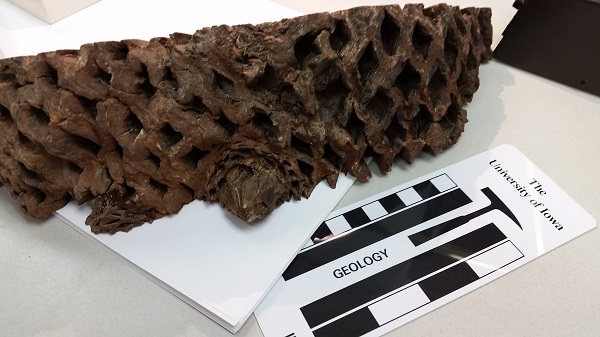Last Friday we examined a very geometric view of an unusual fossil. Here it is in full, complete with scale.

I think it still looks pretty intimidating, but as you can probably tell it is a plant. Specifically, a fossil of Cycadeoidea. There’s a significant amount of controversy about the classifications of species within this genus. At the time this particular fossil was described, it was known as Cycadeoidea dacoit. This specimen is one slice of the holoype (a holotype is the organism used to describe and define the species) of one of the earliest described Cycadeoidea, collected by T.H. MacBride in 1896. These organisms lived during the Jurassic and Cretaceous periods.
You might remember an earlier Fossil Friday, which mentioned Petrified Forest National Park. As I mentioned in that post, Petrified Forest has been pretty well-looted over the years, though there are still many interesting specimens to be seen in the park. Prepare yourself for an even sadder story.
MacBride collected this holotype specimen, as well as many others, from what was known as Cycad National Monument in South Dakota. This important fossil site was discovered in 1892, and was on the books as an official National Monument from 1922–1957. Why was it closed down? Because jerks stole or destroyed ALL of the visible fossils! So lame. Happened quickly, too.
If so many of these fossils had not been stolen and turned into coffee tables or whatever, maybe we’d be better able to classify these organisms. As it is, researchers often find it difficult to associate fossilized leaves with fossilized trunks, and it can be difficult to determine if morphological variations are due to intra-species differences, specimen age, or if the samples include more than one species. Regardless, this holotype specimen is pretty nice. We can clearly see the plant’s reproductive structures—those particularly pointy bits that stick out from the rest of the trunk. Modern cycads produce terminal seed cones or pollen cones on special branches, but these ancient specimens interspersed seed and pollen cones within the trunk itself. An interesting change in body plan over time.
The winner this week? No species level identification was made, but John Macdonell and Dan Coleman got the genus. Congratulations, and thanks for playing! If you have a fossil you want to share, send your pictures to me at schoerning at ncse.com.

